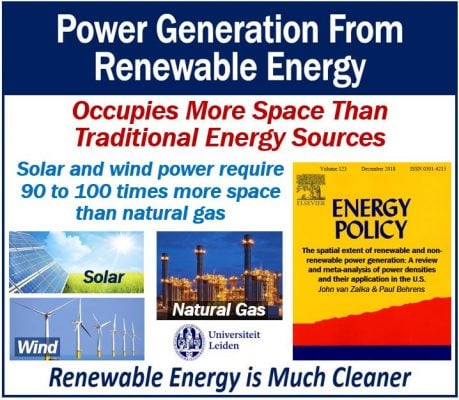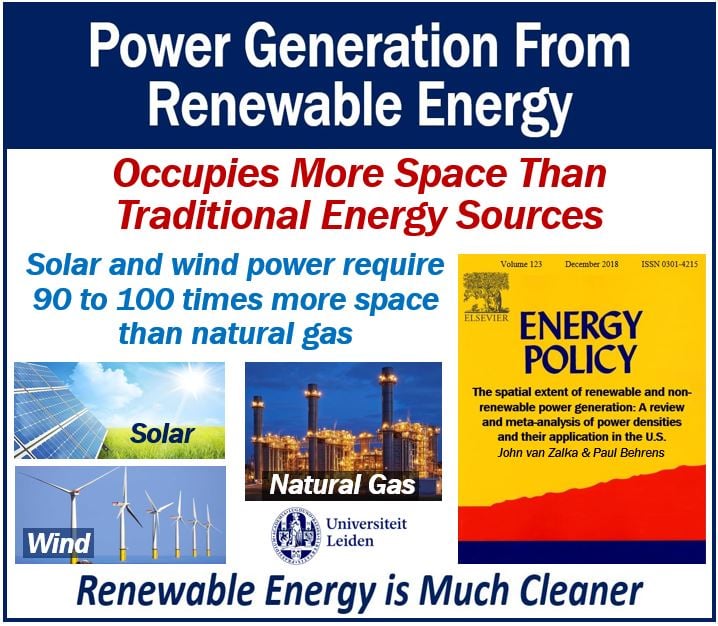Generating renewable energy requires more space than people may think. However, it is much cleaner than traditional fuel sources. Nuclear and natural gas take up the least space. Wind, biomass, and hydro, on the other hand, occupy the most.
Paul Behrens and John van Zalk set out to determine how much space we need for nine different types of energy. Prof. Behrens is an Assistant Professor in Energy and Environmental Change at the University of Leiden in The Netherlands. Behrens is a masters student, also at the University of Leiden.
They wrote about their study and findings in the academic journal Energy Policy (citation below).
The researchers say that the transition to renewable energy will probably change the way our cities look. They will probably also change how our countryside looks. Their appearances will change because renewable energy takes up a lot of space compared to traditional energy sources.
Renewable energy is energy that comes from sources that never run out. We cannot use them up so that there is none left.

Renewable energy – space
Renewable energy needs more space than fossil fuels and nuclear power. The researchers used the concept of power density to compare them. Power density is the average electrical power that one horizontal square meter of infrastructure produces.
Infrastructure is all the systems and structures that modern society needs to function properly. Roads, water systems, sewers, bridges, and tunnels, for example, make up our infrastructure. Rail networks and power generation and distribution also form part of our infrastructure.
For the first time, the researchers gathered and analyzed data regarding 177 estimates of US power densities. They also compared the power densities for nine different types of energy.
They say that we can apply their findings to other countries as well.
Renewable energy – less pollution
The authors found that the power density of energy sources can vary significantly. In some cases, they can vary by well over one thousand times.
Biomass, for example, the lowest, has a power density of 0.8 W/m2. Natural gas, the highest, on the other hand, has a power density of 1000 W/m2.
Wind and solar power require approximately 40-to-50 times more space than coal. Solar and wind power require ninety to one hundred times more space than natural gas.
Regarding pollution, Prof. Behrens said:
“However, the production of fossil fuels is a very dirty business. So, while renewable energies take up more space, that space will be less polluted, and can be developed for multiple uses such as farming around the base of wind turbines.”
Solar power densities
The study showed that solar power densities are continuously increasing. The new 3-dimensional designs, research suggests, could reach more than three to five times the current figures by the year 2050.
The world’s human population continues to grow. This means that we will be requiring more housing and food. Therefore, space will be a premium by the middle of this century.
Regarding the power densities of renewable energy, Prof. Behrens said:
‘The very low power densities of biomass make it a difficult sell, especially since the land on which it is produced can sometimes be used for growing food instead.”
“To avoid competition, rooftop solar will be the best bet – providing clean power that doesn’t compete with other land uses. Offshore wind will help, and future technologies such as algae farms may be another option to avoid land competition.”
Land use for power generation – USA
The researchers applied their power densities to the National Renewable Energy Laboratory’s Renewable Electricity Futures Scenarios.
The US southern states would see a near tripling in land use for power generation. The northeast, however, would experience the greatest change. Over 10% of land in nine northeastern states would be used for power generation.
The National Renewable Energy Laboratory (NREL), in Golden, Colorado, USA, specializes in renewable energy R&D. It also specializes in energy efficiency R&D. The US Department of Energy funds the NREL.
Citation
“The spatial extent of renewable and non-renewable power generation: A review and meta-analysis of power densities and their application in the U.S.” John van Zalka and Paul Behrens. Energy Policy Volume 123, December 2018, Pages 83-91. https://doi.org/10.1016/j.enpol.2018.08.023.

